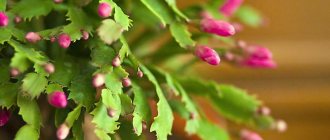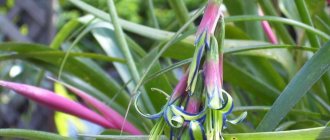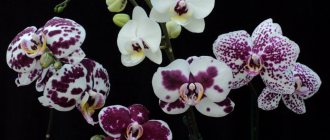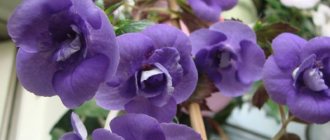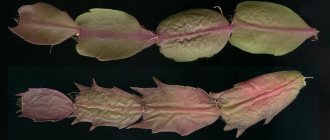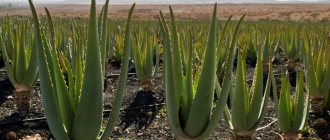Decembrist has many botanical names: Schlumberger cactus, epiphyllanthus, epiphyllum, zygocactus. Among gardeners, they are often called Rozhdestvennik, Christmas cactus, and Decembrina. Belongs to the genus of epiphytic cacti. Its name in common parlance is due to the fact that flowering occurs during the Christmas holidays.
Epiphyllum is the “black sheep” among cacti. Free from thorns, afraid of the sun, has flat leaves made of segments (links) with jagged edges. Showy clusters of tubular flowers appear at the ends of the plant.
The color was originally red, but thanks to the work of breeders, the Christmas tree flaunts yellow, purple, crimson, white and even several flowers at once on one plant.
His home is the tropics in southwest Brazil. Zygocactus grows on trees. Despite the rainfall in these places, little moisture and nutrients remain on the crown and branches. Therefore, caring for Decembrists is simple and the plant is suitable for beginning gardeners.
Brief overview of the article
- Secrets of lush flowering
- Priming
- Top dressing
- Light and temperature
- Watering
- Pruning and propagation
- How does pruning happen?
- Transplantation and propagation
- Pests and their control
- General preventive measures
- Common mistakes in care
- Photo of the Decembrist
Secrets of lush flowering
The secrets are simple, but it’s worth learning the intricacies of caring for a flower. Then photos of exotic Decembrist flowers will delight your loved ones.
Priming
The soil must allow moisture and air to pass through. If you make the soil yourself, the base is sand and leaf humus in equal proportions.
You can add a little charcoal or peat. A no-fuss option is a universal primer. The soil is not suitable for cacti (excess peat).
Light and temperature
Epiphyllum loves light, but not direct light. Pots are placed next to windows facing north. The plant is placed towards the south under the condition of shade or diffused light.
The flower is so unpretentious that it grows and pleases with bright buds even at +10-15 degrees. The optimal range is +18-25 °C. Doesn't like sudden changes in temperature.
Lighting
For full growth, the yellow Decembrist requires diffused light, so it does not have to be grown on a windowsill, but can be placed in the back of the room, but so that direct sunlight does not fall on the plant.
During the first dormant period, when the flower is preparing to bloom, it is necessary to artificially shorten the daylight hours. To do this, in the evening it should be covered with an opaque cloth or locked in a dark room. This will allow more buds to form.
In the warm season, it is recommended to place the flower pot on a loggia or balcony in a shaded place, this will improve the growth of young shoots. The plant must be placed away from drafts.
Watering
Christmas trees are watered more often than ordinary cacti, but they are guided by the time of year. During flowering, it is watered frequently, focusing on 1-3 cm of dried soil. After flowering, gardeners reduce the frequency of watering and moisten the soil when it is completely dry.
In summer, showering or wiping the leaves with a damp cloth is important for zygocactus. Water the plant with water at room temperature. Cold tap water will kill the roots.
Formation of flower stalks
A peduncle is formed on the extreme segment of each branch of the plant. It gradually matures and at a certain moment the Decembrist flowering begins. The size of the opened flower is from 5 to 8 cm in length. The inflorescences can be crimson, white, scarlet, orange, peach and lavender.
Pruning and propagation
Pruning is necessary after the plant has flowered. Long drooping leaves are beautiful, but the nutritional elements will not reach the flower. For lush flowering, you should form a crown that is slightly larger than the diameter of the pot.
Important! If a plant has smaller flowers than in the previous year, this is a signal: the necessary substances do not reach them.
Is it possible to achieve coloring yourself?
Such experiments can only be carried out by experienced breeders working on the development of new varieties. You can try to cross the houses, but you shouldn’t count on such a result - the genetic changes of the Decembrist have not been fully studied and may turn out to be unpredictable .
The color of a flower is influenced not only by hereditary factors, but also by climatic conditions. If the temperature is not maintained above 15 C during the period from bud formation to full flowering, the flowers will most likely acquire a pinkish tint.
How does pruning happen?
For pruning, no tools are needed except the caring hands of the housewife. You should hold the sheet from below and make twisting movements. The leaf segments come off easily.
If the plant is many years old, some leaves will branch in two directions, forming the English letter Y. To trim them, you need to leave 1 segment of the branch on each side.
This is interesting: After pruning, the flower can bloom again in March.
One of the representatives of cacti
At first glance at the plant, it is difficult to imagine that Decembrist is a type of cactus. His appearance is not typical for representatives of cacti. Many flat-shaped segments, on the sides of which there are characteristic notches, make up the leafy part of the plant.
Decembrist is completely devoid of needles, unlike traditional cacti. Flexible stems hang spreadingly, resembling a fountain.
Transplantation and propagation
A young plant needs to be replanted every year. For Zygocactus that is more than 5 years old, the container is changed as needed.
After flowering, in early spring, the zygocactus is replanted. In water, the cuttings may not take root, so they are planted directly in a pot with holes. Ideally, replanting is combined with pruning.
Planting Decembrist flowers is not difficult. Useful:
- 3 cuttings with two segments per 1 pot;
- small pots;
- expanded clay;
- vermiculite 1/10 (mineral to keep the soil loose);
- universal primer;
- small spatula or mixing tool.
Expanded clay is poured onto the bottom, filled with soil and vermiculite, mixing the last two ingredients with a shovel. You can fill it almost to the edges of the container, make a small depression and pour in a little water.
Next, plant 3 cuttings per pot. This way they will take root faster and create a root system. The cutting needs to be deepened into the ground by half a segment. It is important to monitor soil moisture and do not overwater.
History of the creation of the species
You may be interested in:When to plant grape cuttings: the best time for planting, breeding features, recommendations for cultivation and care
Decembrist Gold Charm is the first yellow plant variety. This species was obtained through the efforts of the American breeder R. L. Cobia in the 80s of the last century. The difficulty of breeding was that in nature there are species with an orange-red tint, but not with yellow ones.
First of all, species with a predominance of yellow over red were selected, since orange is a combination of red and yellow. As a result, about 50 thousand seeds were obtained. But only 1 plant of them had a yellowish color, although the bush itself was very weak.
To correct this, the plant was re-crossed, but with a white variety of the crop, characterized by a strong skeleton and a long flowering period. Of the 150 specimens ultimately received, only 1 flower had a soft yellow color, but the bush was well formed and had strong shoots. It was this plant that became the basis of the Gold Charm variety.
Pests and their control
The Christmas tree is susceptible to serious illnesses. They are divided into fungal, bacterial and insect-related diseases.
Fungi include:
- Pathogens of fusarium. Signs lie in dry, light lesions on the edges of the shoots. Fungal spores are easily airborne. If left untreated for a long time, the root system dies.
- Pathogens of late blight. The leaves acquire a dull gray tint and wither. In the root area, the stems rot, and the segments on the Decembrist crumble.
- Cladode rot. The spores on the leaves are black in color and take on a round shape.
Chemical fungicides are used to treat fungal infections. These can be “Fundazol”, “Fitosporin”, copper sulfate solution (Bordeaux mixture).
Attention! The healthy part of the plant can be cut, but it must be pre-treated with a fungicide.
Of the bacterial types, soft rot occurs. The lesion is black, slimy, starts from below at the soil line and spreads to the leaves. It is better not to joke with excessive feeding and humidity; remove diseased leaves in a timely manner. Chemical treatment is ineffective.
Uninvited insect guests also cause trouble.
- The activity of a spider mite can be determined by a rusty coating, white spots on the leaves and cobwebs. The resident himself comes in yellow, brown and scarlet colors. When such signs appear, use the drugs “Actellik”, “Neoron”, “Fitoverm”. It is necessary to treat the affected plant and its neighbors. Wipe the window sills with alcohol.
- The work of the scale insect is determined by brown spots at the bottom of the leaves in the center, loss of shine in the plant, and the absence of new shoots. You need to clean off the insects with a brush or rag dipped in soapy water. Treat the plant and pot with Fitoverm.
- Mealybugs leave cotton balls on leaves and flowers on the top or back side. Remove the discharge with a brush. Zygocactus is treated with a soap solution (half soap per liter of water, left overnight) and sprayed 4 times with an interval of 2 weeks.
Feeding
During the active growing season, forest cactus needs nitrogenous fertilizers. But at the same time, the dosage of the drug should be reduced by 2 times from that indicated in the annotation. The frequency of fertilizing is once every 2-3 weeks.
During preparation for flowering, yellow Decembrist should be fertilized with preparations with a high content of potassium and phosphorus. In this case, you can use eggshells. It should be soaked in 1 liter of water and left for 24 hours. After this, use the solution to water the plant. The frequency of fertilizing during this period is once every 2 weeks.
Excessive application of fertilizers negatively affects the flowering and development of the bush.
Common mistakes in care
Frequent rearrangement of the flower from place to place. Although caring for a Decembrist at home is simple, he will not tolerate a permanent change of residence. A banal turning of the pot will bring stress to the Christmas boy. Especially during flowering: it will drop flowers.
In winter it is not artificially illuminated.
No rest period for 1.5 months (approximately September-October). After a summer with intensive watering and fertilizing, the plant must be placed in a room with low temperatures and watering should be practically eliminated. This is easy to do: in city apartments it is cool until the heating is turned on, this can be called a period of rest.
Tip: To avoid confusion with watering, you can make a sign or sticker that says “Don’t water me.”
Transplant into a large pot. The root system of the Schlumbergera cactus is small. Flowering will occur in 3-5 years.
Decembrist with exotic showy flowers is a godsend for a gift, especially during the New Year holidays. A minimum of effort in care, if you know the intricacies of the flower, will delight the owner for decades.
The best varieties of Schlumbergera
Of all the existing types of epiphyllum, only three bloom on windowsills:
- Schlumbergera Buckley (Schlumbergera bouclei, or buckley) is the oldest “inhabitant” of window sills, which received the name “Decembrist”. Ampelous plant. The length of the arched hanging shoots of the flower is 40–50 cm. The segments are elongated, with rounded protrusions of a bright green color. The flower tubes are symmetrical, multi-tiered, up to 8 cm in length. The color is bright, raspberry-pink;
- Schlumbergera trunkatus has larger flowers and branches. The height of the flower reaches 50 cm. The stems are less drooping and light green in color. The segments are large: 5–6 cm in length and 2.5–3.5 cm in width. The segments have a chopped shape and sharp protrusions along the edges. The flower tube is not symmetrical, but oblique (truncated). The petals are large and curved. There are a variety of colors, often with bordering. The blooming buds have a bizarre shape, reminiscent of a bird in flight;
- Schlumbergera russeliana is low, up to 30 cm. The branches are glossy, with a pronounced vein in the center of each segment. The segments are small (3.5 cm long and 2 cm wide), without spines or points. The peduncle is long and greenish. Flowers with pointed petals in different shades of pink, red and purple.
Based on these three types of Christmas tree, breeders have developed many hybrid varieties that differ in shape and color. Scientists have not yet been able to obtain a zygocactus with blue flowers.
Here are some of the popular varieties:
- Angel Dance delights with the dazzling whiteness of the flowers. Unlike other white Christmas trees, it has snow-white not only petals, but also a long pistil. The color does not change due to temperature changes;
- Malissa has a low bush with shiny small segments. The flowers are quite large, the petals are round, crystal white, and the pistil hanging down is soft pink;
- Ascot blooms with bright red flowers. They are large, terry, with fringed petals;
- Samba Brazil is a bright flower that resembles the colorful dress of a samba dancer. The petals are wide, rounded, tricolor. The white throat extends into the yellow center of the petal and ends with a cherry-red edge;
- Christmas Cheer - Decembrist with delicate orange flowers. Round petals with pointed ends are collected in a beautiful elegant basket;
- Ara Brazil is a colorful and elegant Christmas tree. The petals are fiery red, becoming lighter towards the center. The flower really looks like a red macaw flying among green leaves;
- Cambridge - Decembrina with bright yellow flowers and backward-curved petals. The jointed stems grow vertically;
- Polka Dancer resembles a burning lilac flame. The petals are round, bright fuchsia in color, have a light stripe on the reverse side, and do not bend back.

